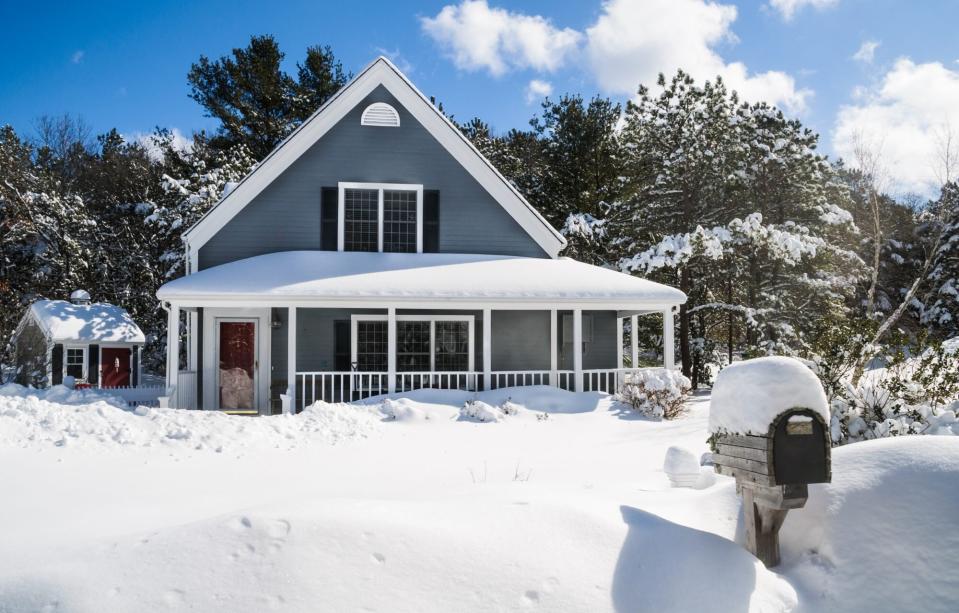Six Home Checks to Make After a Winter Storm
Whatever the season, homeowners have a year-round priority: Keeping their house in the best possible condition. Spring, summer, and fall all come with weather conditions to monitor, but winter brings extremely low temperatures, snow, and ice that can wreak havoc on a home's façade. "Regarding the exterior, shingles can get water under them if they are not fastened to the roof sufficiently, which can cause damage to the shingles themselves and possibly to the woodwork under the roof," Alan Reppert, a senior meteorologist at AccuWeather, says. "Accumulated snow can melt and cause an ice jam in the gutters, allowing large icicles to form. These icicles can damage both the gutters and downspouts—and even lead to ice around the house that can be dangerous."
To help your home recover from the the conditions winter can bring, we listed some expert-approved home checks (both indoors and out) to make after a storm passes through your locale.
Related: What's the Difference Between a Snowstorm and a Blizzard?

KenWiedemann / Getty Images
Check your roof.
"In freezing temperatures, ice dams can form when heat rises and melts the ice and snow on your roof," Steve Wilson, Hippo's home insurance expert, notes. This water can drip down, refreeze, and cause dams that can block your drains and weaken your roof. It could collapse altogether as a result. Watch for clusters of icicles around the sides of your roofline, which are a sign of this issue; a sagging roof is another indicator that an extreme storm has compromised its integrity. "This is especially a concern if there is heavy, wet snow and after repeated snowstorms, when several inches of snow have already accumulated on a roof," Reppert shares. "If there is a significant winter storm with a large amount of snow, even without sagging, the snow may need to be removed to avoid damage." Inspect the area to ensure that no other debris, like tree limbs, is left behind.
Inspect home appliances.
Mike Bidwell, the president and CEO of Neighborly, recommends taking an inventory of your home appliances and equipment after a storm. Ask yourself these questions: What items are no longer working? Which items potentially have water or electrical damage? At this point, you can connect with service professionals for help.
Keep an eye on your attic.
Make your way to your attic and check the areas near your pipes, vents, lighting fixtures, and chimneys. Reppert notes that adding ventilation to your attic—long before storms hit—can be beneficial, so cool air can move through the space while insulation seals in heat. (Before winter comes, check the roof flashing to make sure that it is in good condition and can prevent water penetration.)
Protect your home's pipes.
Add an extra layer of protection to your pipes during inclement winter conditions. "Wrapping pipes, ensuring there's proper insulation in the surrounding walls, and maintaining regulated temperatures inside the home can help prevent burst pipes," Wilson says. "Another helpful tip is to keep the temperature in the home regulated above 55 degrees, especially if you're headed on vacation."
Test your fireplace or chimney.
Have a trained heating technician inspect your heating system following a winter storm, including chimneys and vents, Bidwell advises. "Clear the snow from a heat pump if the house has one and clear the snow from any vents for hot water heaters, furnaces, or any cars outdoors before they are started," he adds. "Also, if you lose power and use a generator, please make sure it is installed by a professional and is not bringing carbon monoxide back into your home or garage." Wilson recommends setting a schedule for these systems' seasonal checkups to avoid needing retroactive help mid-winter.
Document damage and communicate with your insurance company.
If you do experience damage to your home or your belongings in a storm, document it all with photos or by video. Then, speak with your insurance agents and contractors to talk through winter storm recovery claims. "Stay tuned to your TV or radio during winter storm recovery for information on assistance available in your area through governments or other organizations," Bidwell says.

